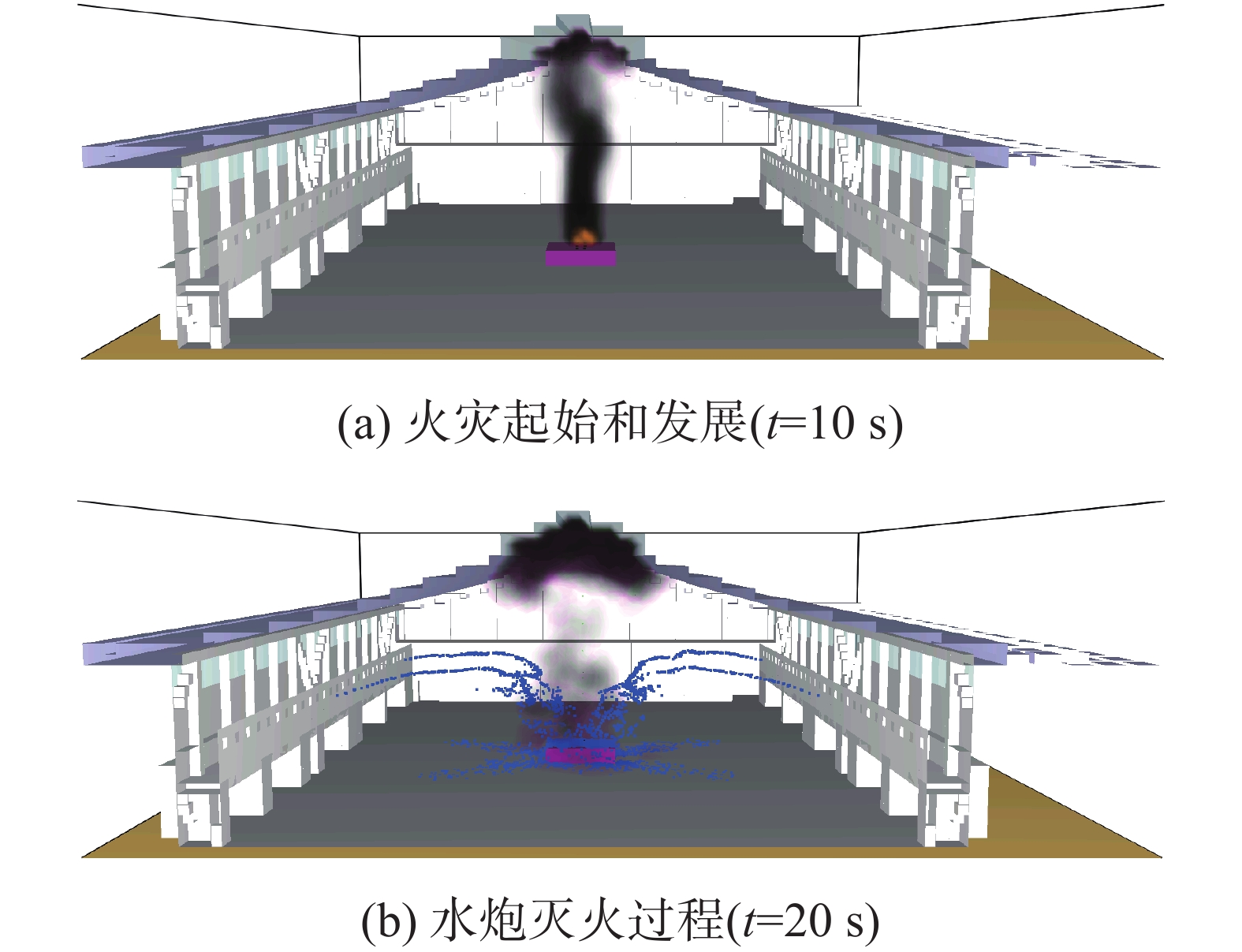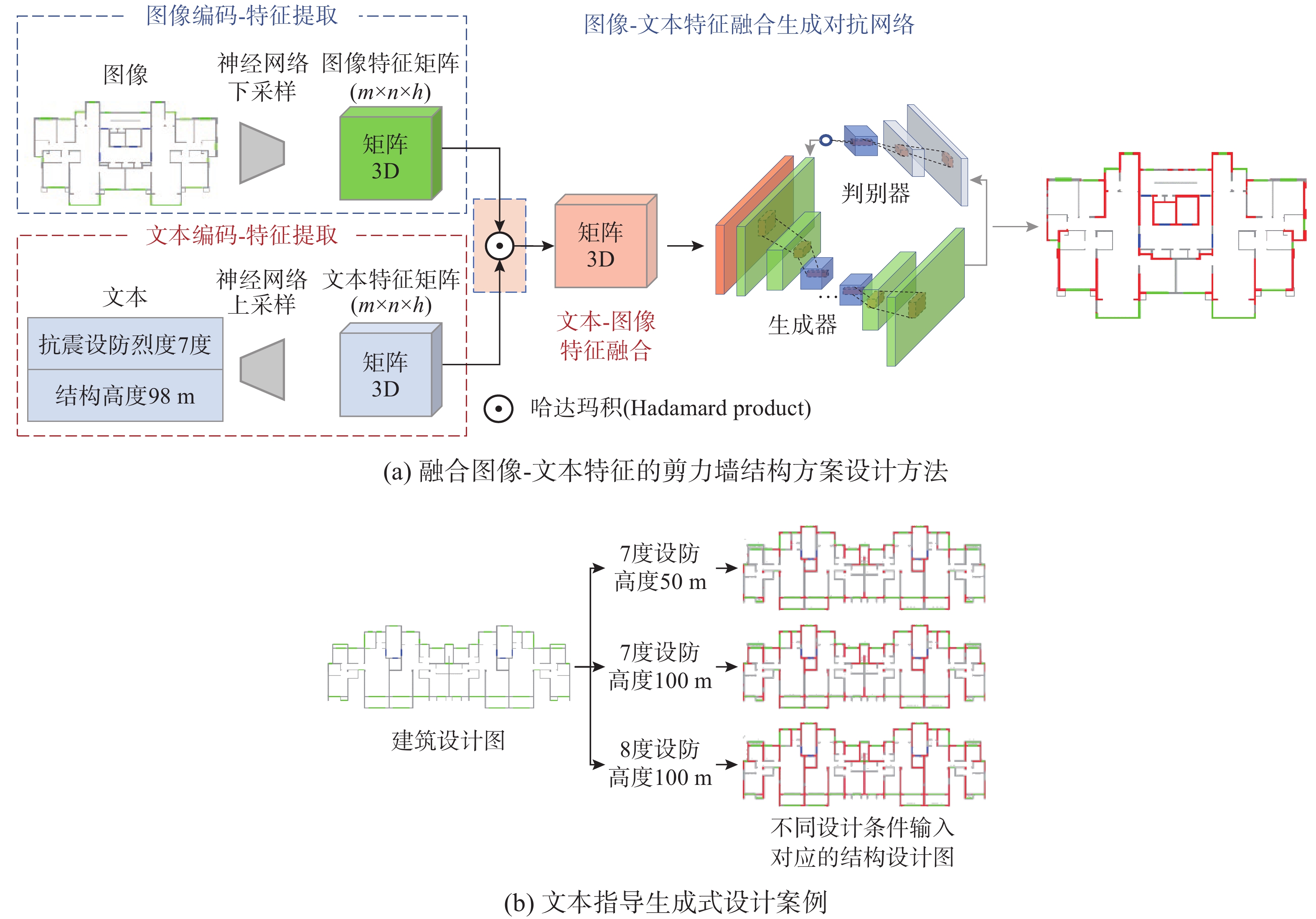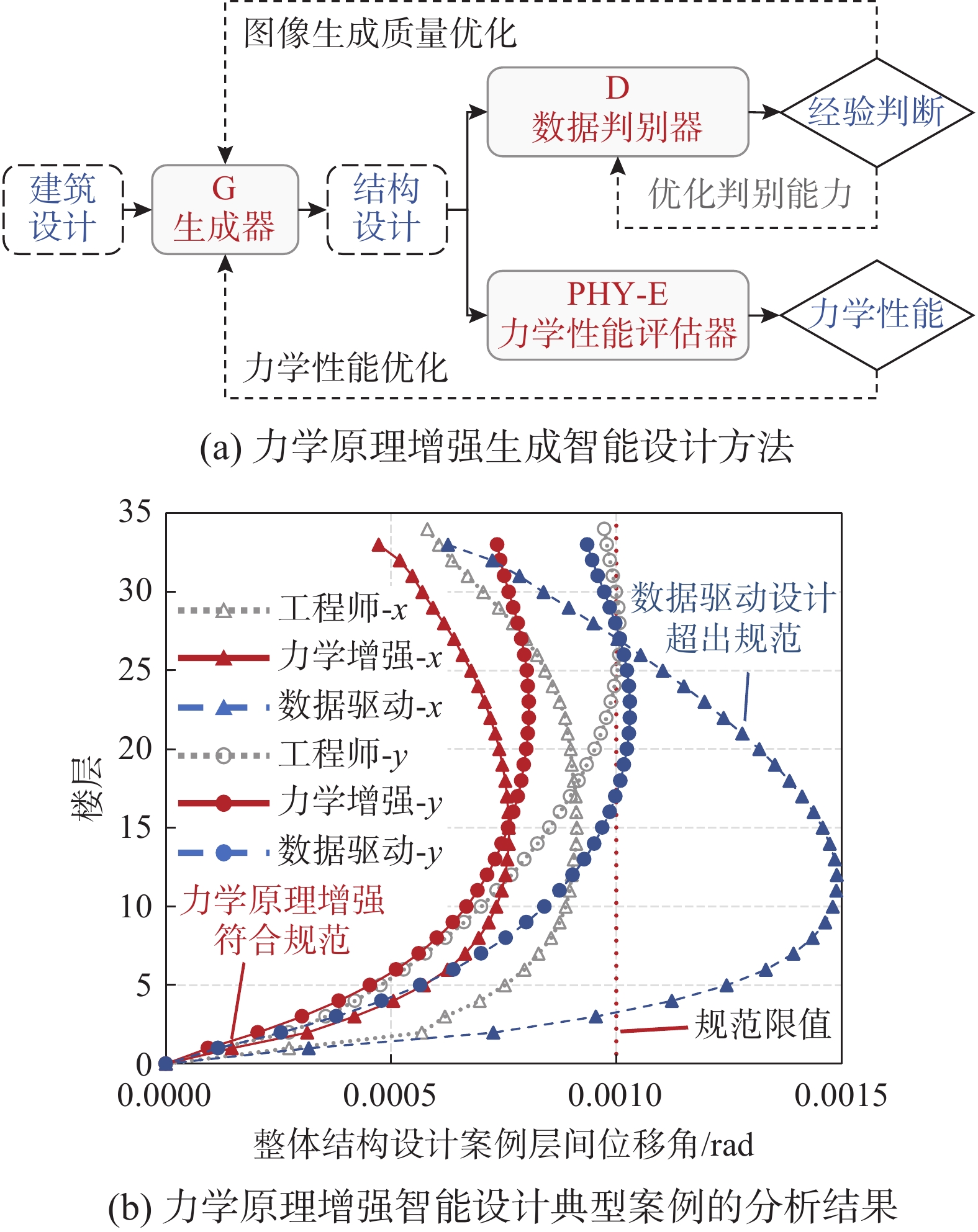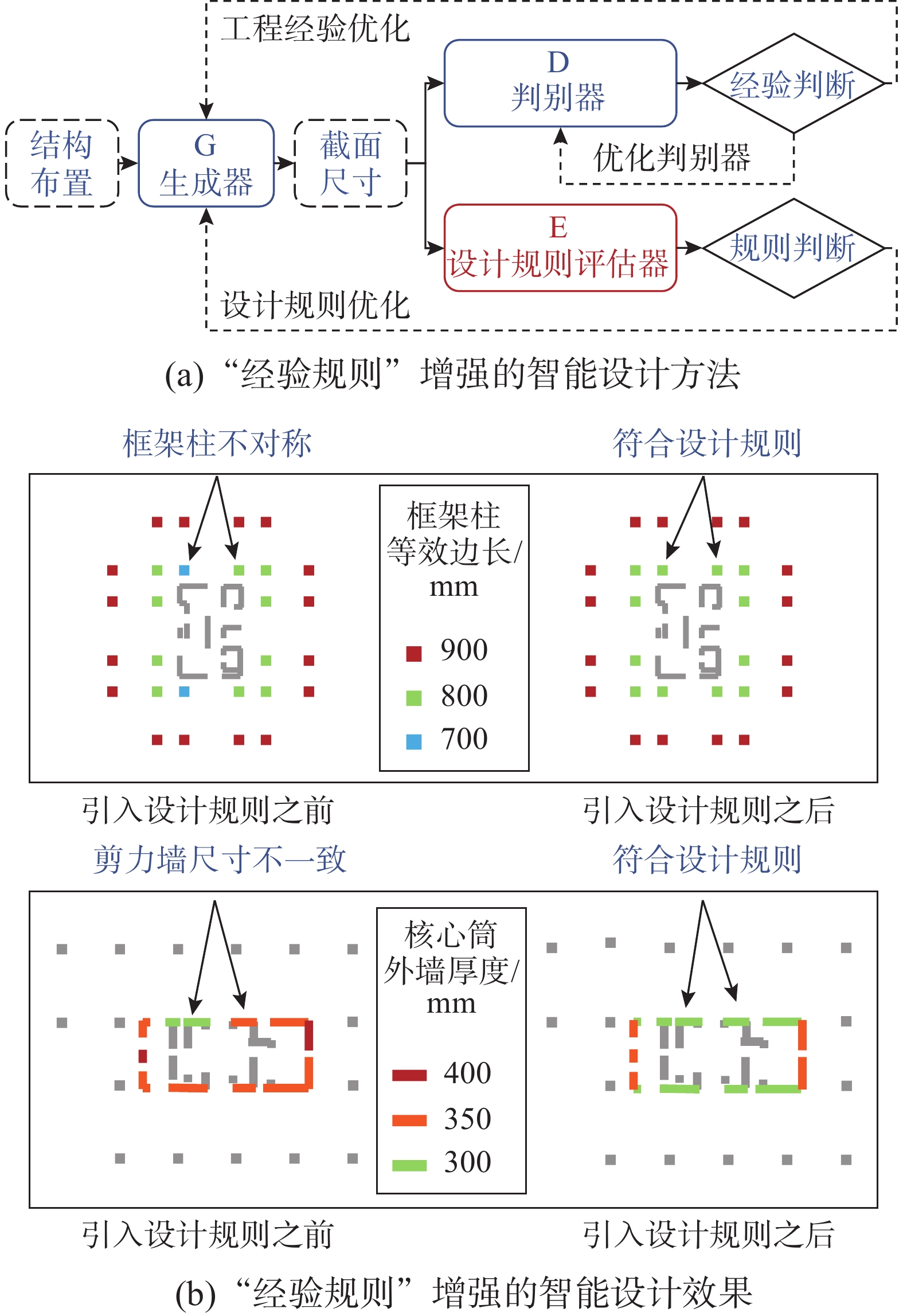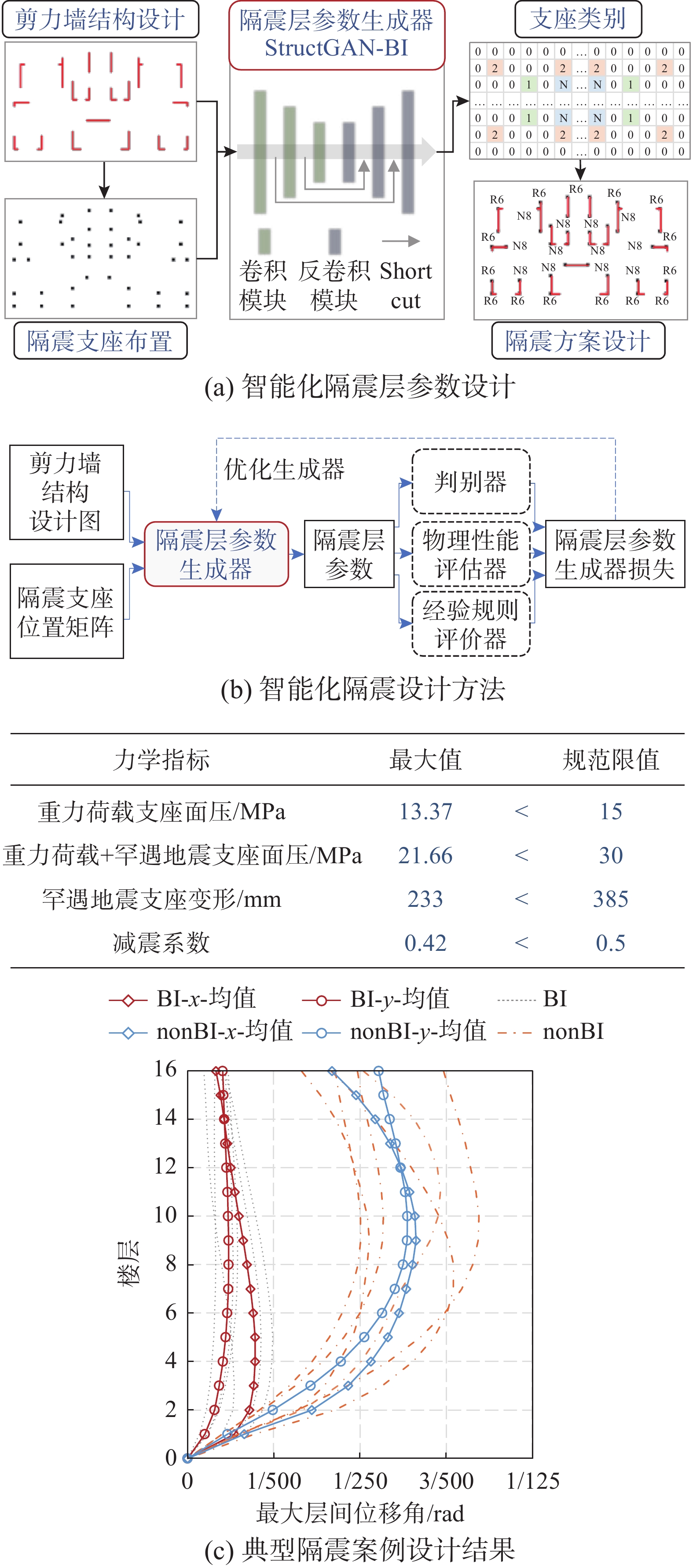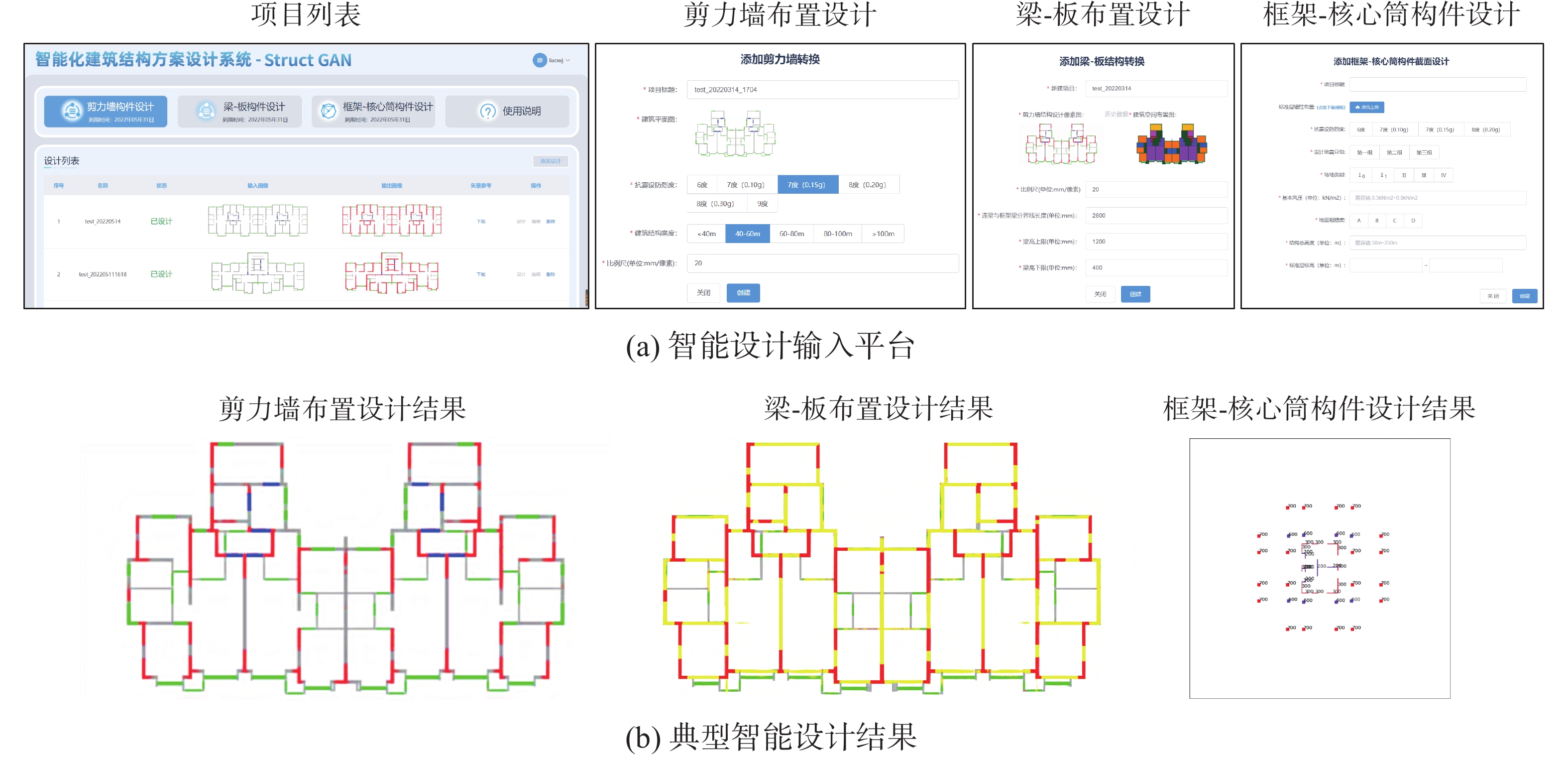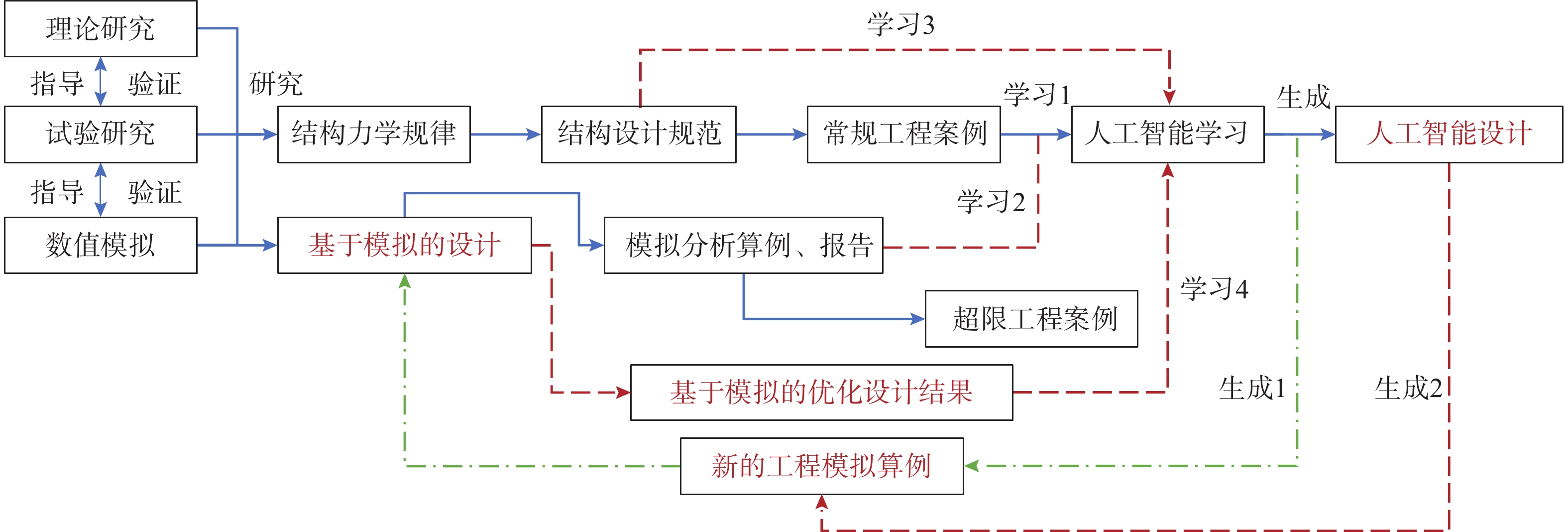RESEARCH PROGRESS ON BUILDING STRUCTURAL DESIGN METHODS: FROM SIMULATION-BASED TO ARTIFICIAL INTELLIGENCE-BASED
-
摘要:
建筑结构设计随着计算机技术进步迈入新的发展阶段,基于模拟与基于人工智能的设计为两个重要发展方向。基于模拟的设计为超出设计规范的特殊结构或特殊工况设计提供了关键手段,其关键难题是发展可以准确、高效模拟结构在地震、火、风等灾害作用下受力行为的模拟方法。基于人工智能的设计则是通过学习既有设计案例,从而高效生成满足工程经验和设计规范要求的结构设计图,可以有效提升结构设计效率,其关键难题在于对工程经验和结构特征的学习和表达。该文介绍了作者团队开展的基于模拟的抗震、防火、抗风设计的典型案例,以及基于生成对抗网络和图神经网络的人工智能结构设计方法,提出了L0~L5不同层级结构智能设计的划分建议,并展望了未来将基于模拟的设计和基于人工智能的设计相融合的发展方向。
Abstract:With the advancement of computer technology, building structural design has entered a new stage of development, and simulation-based and artificial intelligence (AI)-based design are two significant development avenues. Simulation-based design is an essential tool for designing complex and unique structures or under special loading conditions beyond the design specifications. The primary obstacle is to develop a simulation approach that can accurately and effectively represent the mechanical behavior of structures under earthquake, fire, wind, and other disasters. Moreover, by learning from existing design cases, AI-based design can efficiently develop structural design drawings that fulfill the needs of engineering experience and design standards, thereby improving the efficiency of structural design. The critical difficulty lies in the learning and expression of engineering knowledge and structural features. This paper describes the typical cases of simulation-based seismic, fire-resistant, and wind-resistant designs conducted by the author’s team, along with the intelligent structural design techniques based on generative adversarial networks and graph neural networks. Different intelligent structural design levels (L0-L5) are proposed. In addition, the paper proposes the future development direction of the combination of simulation-based design with AI-based design.
-
-
-
[1] 吕西林, 李学平. 超限高层建筑工程抗震设计中的若干问题[J]. 建筑结构学报, 2002, 23(2): 13 − 18. LYU Xilin, LI Xueping. Some problems on seismic design of out-of-codes highrise buildings [J]. Journal of Building Structures, 2002, 23(2): 13 − 18. (in Chinese)
[2] 汪大绥, 周建龙, 袁兴方. 上海环球金融中心结构设计[J]. 建筑结构, 2007, 37(5): 8 − 12. WANG Dasui, ZHOU Jianlong, YUAN Xingfang. Structural design of shanghai world financial center [J]. Building Structure, 2007, 37(5): 8 − 12. (in Chinese)
[3] 刘鹏, 殷超, 程煜, 等. 北京CBD核心区Z15地块中国尊大楼结构设计和研究[J]. 建筑结构, 2014, 44(24): 1 − 8. LIU Peng, YIN Chao, CHENG Yu, et al. Structural design and research of Beijing CBD Core Area Z15 plot China Zun Tower [J]. Building Structure, 2014, 44(24): 1 − 8. (in Chinese)
[4] LIAO W J, LU X Z, HUANG Y L, et al. Automated structural design of shear wall residential buildings using generative adversarial networks [J]. Automation in Construction, 2021, 132: 103931. doi: 10.1016/j.autcon.2021.103931
[5] SUN H, BURTON H V, HUANG H L. Machine learning applications for building structural design and performance assessment: State-of-the-art review [J]. Journal of Building Engineering, 2021, 33: 101816. doi: 10.1016/j.jobe.2020.101816
[6] MÁLAGA-CHUQUITAYPE C. Machine learning in structural design: An opinionated review [J]. Frontiers in Built Environment, 2022, 8: 815717. doi: 10.3389/fbuil.2022.815717
[7] PIZARRO P N, HITSCHFELD N, SIPIRAN I, et al. Automatic floor plan analysis and recognition [J]. Automation in Construction, 2022, 140: 104348. doi: 10.1016/j.autcon.2022.104348
[8] ODEN J T, BELYTSCHKO T, FISH J, et al. Simulation-based engineering science-revolutionizing engineering science through simulation [R]. Alexandria: National Science Foundation, 2006.
[9] 达摩院. 达摩院: 2022十大科技趋势[R]. 杭州: 达摩院, 2021. Alibba Damo Academy. Top ten technology trends of Damo academy [R]. Hangzhou: Alibba Damo Academy, 2021. (in Chinese)
[10] 陆新征, 蒋庆, 缪志伟, 等. 建筑抗震弹塑性分析[M]. 2版. 北京: 中国建筑工业出版社, 2015. LU Xinzheng, JIANG Qing, MIAO Zhiwei, et al. Elasto-plastic analysis of buildings against earthquake [M]. 2nd ed. Beijing: China Architecture & Building Press, 2015. (in Chinese)
[11] LECUN Y, BENGIO Y, HINTON G. Deep learning [J]. Nature, 2015, 521(7553): 436 − 444. doi: 10.1038/nature14539
[12] KRIZHEVSKY A, SUTSKEVER I, HINTON G E. ImageNet classification with deep convolutional neural networks [J]. Communications of the ACM, 2017, 60(6): 84 − 90. doi: 10.1145/3065386
[13] LU X Z, LIAO W J, ZHANG Y, et al. Intelligent structural design of shear wall residence using physics-enhanced generative adversarial networks [J]. Earthquake Engineering & Structural Dynamics, 2022, 51(7): 1657 − 1676.
[14] LIAO W J, HUANG Y L, ZHENG Z, et al. Intelligent generative structural design method for shear wall building based on "fused-text-image-to-image" generative adversarial networks [J]. Expert Systems with Applications, 2022, 210: 118530. doi: 10.1016/j.eswa.2022.118530
[15] ZHAO P J, LIAO W J, HUANG Y L, et al. Intelligent design of shear wall layout based on attention-enhanced generative adversarial network [J]. Engineering Structures, 2023, 274: 115170. doi: 10.1016/j.engstruct.2022.115170
[16] ZHAO P J, LIAO W J, XUE H J, et al. Intelligent design method for beam and slab of shear wall structure based on deep learning [J]. Journal of Building Engineering, 2022, 57: 104838. doi: 10.1016/j.jobe.2022.104838
[17] ZHAO P J, LIAO W J, HUANG Y L, et al. Intelligent beam layout design for frame structure based on graph neural networks [J]. Journal of Building Engineering, 2022, 63: 105499.
[18] FEI Y F, LIAO W J, HUANG Y L, et al. Knowledge-enhanced generative adversarial networks for schematic design of framed tube structures [J]. Automation in Construction, 2022, 144: 104619. doi: 10.1016/j.autcon.2022.104619
[19] FEI Y F, LIAO W J, ZHANG S, et al. Integrated schematic design method for shear wall structures: A practical application of generative adversarial networks [J]. Buildings, 2022, 12(9): 1295. doi: 10.3390/buildings12091295
[20] LIAO W J, WANG X Y, FEI Y F, et al. Base‐isolation design of shear wall structures using physics‐rule‐co‐guided self‐supervised generative adversarial networks [J]. Earthquake Engineering & Structural Dynamics, 2023, 52(11): 3281 − 3303.
[21] PKPM. PKPM V5软件说明书-多层及高层建筑结构分析与设计软件SATWE使用指南[M]. 北京: 北京构力科技有限公司, 2021. PKPM. PKPM V5 software manual - multi-storey and high-rise building structural analysis and design software SATWE user guide [M]. Beijing: Beijing Glory PKPM Technology Co. , Ltd. , 2021. (in Chinese)
[22] 北京盈建科软件股份有限公司. 结构计算软件YJK-A用户手册及技术条件[M]. 北京: 北京盈建科软件股份有限公司, 2014. Beijing Yingjianke Software Co., Ltd. Structural analysis software YJK-A user manual and technical conditions [M]. Beijing: Beijing Yingjianke Software Co., Ltd., 2014. (in Chinese)
[23] ZHANG Y, MUELLER C. Shear wall layout optimization for conceptual design of tall buildings [J]. Engineering Structures, 2017, 140: 225 − 240. doi: 10.1016/j.engstruct.2017.02.059
[24] TAFRAOUT S, BOURAHLA N, BOURAHLA Y, et al. Automatic structural design of RC wall-slab buildings using a genetic algorithm with application in BIM environment [J]. Automation in Construction, 2019, 106: 102901. doi: 10.1016/j.autcon.2019.102901
[25] GB 18306−2015, 中国地震动参数区划图[S]. 北京: 中国标准出版社, 2016. GB 18306−2015, Seismic ground motion parameters zonation map of China [S]. Beijing: Standards Press of China, 2016. (in Chinese)
[26] GB/T 51408−2021, 建筑隔震设计标准[S]. 北京: 中国计划出版社, 2021. GB/T 51408−2021, Standard for seismic isolation design of building [S]. Beijing: China Planning Press, 2021. (in Chinese)
[27] T/CECS 392−2021, 建筑结构抗倒塌设计标准[S]. 北京: 中国计划出版社, 2021. T/CECS 392−2021, Standard for anti-collapse design of building structures [S]. Beijing: China Planning Press, 2021. (in Chinese)
[28] LU X Z, GUAN H. Earthquake disaster simulation of civil infrastructures: From tall buildings to urban areas [M]. 2nd ed. Singapore: Springer, 2021.
[29] GB 50011−2010, 建筑抗震设计规范[S]. 北京: 中国建筑工业出版社, 2010. GB 50011−2010, Code for seismic design of buildings [S]. Beijing: China Architecture & Building Press, 2010. (in Chinese)
[30] 赵鹏举, 于晓辉, 陆新征. 基于显式算法的RC框架结构抗地震倒塌能力分析[J]. 工程力学, 2020, 37(3): 77 − 87. doi: 10.6052/j.issn.1000-4750.2019.04.0165 ZHAO Pengju, YU Xiaohui, LU Xinzheng. Collapse capacity assessment of RC frame structures using explicit algorithm [J]. Engineering Mechanics, 2020, 37(3): 77 − 87. (in Chinese) doi: 10.6052/j.issn.1000-4750.2019.04.0165
[31] FEMA P-58, Development of next generation performance-based seismic design procedures for new and existing buildings [S]. Redwood City, California: Applied Technology Council, 2012.
[32] GB/T 38591−2020, 建筑抗震韧性评价标准[S]. 北京: 中国标准出版社, 2020. GB/T 38591−2020, Standard for seismic resilience assessment of buildings [S]. Beijing: Standards Press of China, 2020. (in Chinese)
[33] VAMVATSIKOS D, CORNELL C A. Incremental dynamic analysis [J]. Earthquake Engineering & Structural Dynamics, 2002, 31(3): 491 − 514.
[34] LU X, LU X Z, GUAN H, et al. Application of earthquake-induced collapse analysis in design optimization of a supertall building [J]. The Structural Design of Tall and Special Buildings, 2016, 25(17): 926 − 946. doi: 10.1002/tal.1291
[35] CHOW W K. Performance-based approach to determining fire safety provisions for buildings in the Asia-Oceania regions [J]. Building and Environment, 2015, 91: 127 − 137. doi: 10.1016/j.buildenv.2015.04.007
[36] FORNEY G P. Smokeview (version 5)-a tool for visualizing fire dynamics simulation data, volume I: User's guide [R]. Gaithersburg, MD: National Institute of Standards and Technology, 2017.
[37] HELBING D, FARKAS I, VICSEK T. Simulating dynamical features of escape panic [J]. Nature, 2000, 407(6803): 487 − 490. doi: 10.1038/35035023
[38] PYAKUREL U. Network flow models for evacuation planning [J]. Journal of the Institute of Engineering, 2017, 13(1): 90 − 101.
[39] 任文, 赵金城, 华莹. 火灾下建筑结构抗火性能和人员疏散研究[J]. 防灾减灾工程学报, 2018, 38(1): 168 − 177. REN Wen, ZHAO Jincheng, HUA Ying. Study of fire resistance of building structures and evacuation under fire [J]. Journal of Disaster Prevention and Mitigation Engineering, 2018, 38(1): 168 − 177. (in Chinese)
[40] KORHONEN T, HOSTIKKA S. Fire dynamics simulator with evacuation: FDS+Evac: Technical reference and user's guide [R]. Espoo: VTT Technical Research Centre of Finland, 2009.
[41] 许镇, 张宗才, 陆新征, 等. 基于BIM和FEMAP-58的建筑地震次生火灾模拟[J]. 消防科学与技术, 2018, 37(6): 745 − 749. XU Zhen, ZHANG Zongcai, LU Xinzheng, et al. Building post-earthquake fire simulation based on BIM and FEMA P-58 [J]. Fire Science and Technology, 2018, 37(6): 745 − 749. (in Chinese)
[42] 张维, 于航. 超大展厅防火设计研究: 以石家庄国际展览中心为例[J]. 住区, 2019(3): 124 − 134. ZHANG Wei, YU Hang. Research on fire prevention design of super large exhibition hall: Taking Shijiazhuang international exhibition center as an example [J]. Design Community, 2019(3): 124 − 134. (in Chinese)
[43] ELSHAER A, ABOSHOSHA H, BITSUAMLAK G, et al. LES evaluation of wind-induced responses for an isolated and a surrounded tall building [J]. Engineering Structures, 2016, 115: 179 − 195. doi: 10.1016/j.engstruct.2016.02.026
[44] ZHANG Y, HABASHI W G, KHURRAM R A. Predicting wind-induced vibrations of high-rise buildings using unsteady CFD and modal analysis [J]. Journal of Wind Engineering and Industrial Aerodynamics, 2015, 136: 165 − 179. doi: 10.1016/j.jweia.2014.11.008
[45] ABOSHOSHA H, ELSHAER A, BITSUAMLAK G T, et al. Consistent inflow turbulence generator for LES evaluation of wind-induced responses for tall buildings [J]. Journal of Wind Engineering and Industrial Aerodynamics, 2015, 142: 198 − 216. doi: 10.1016/j.jweia.2015.04.004
[46] ADAMEK K, VASAN N, ELSHAER A, et al. Pedestrian level wind assessment through city development: A study of the financial district in Toronto [J]. Sustainable Cities and Society, 2017, 35: 178 − 190. doi: 10.1016/j.scs.2017.06.004
[47] JACOB J, SAGAUT P. Wind comfort assessment by means of large eddy simulation with lattice Boltzmann method in full scale city area [J]. Building and Environment, 2018, 139: 110 − 124. doi: 10.1016/j.buildenv.2018.05.015
[48] HUANG S H, LI R, LI Q S. Numerical simulation on fluid-structure interaction of wind around super-tall building at high reynolds number conditions [J]. Structural Engineering and Mechanics, 2013, 46(2): 197 − 212. doi: 10.12989/sem.2013.46.2.197
[49] 黄铭枫, 唐归, 陶慕轩, 等. 赛格广场大厦楼顶双桅杆结构的风致高阶涡振分析[J]. 建筑结构学报, 2022, 43(12): 1 − 10. HUANG Mingfeng, TANG Gui, TAO Muxuan, et al. Wind-induced high-order vibration of a twin-mast with large cross-section at top of Saige Plaza Building [J]. Journal of Building Structures, 2022, 43(12): 1 − 10. (in Chinese)
[50] HUANG W X, ZHENG H. Architectural drawings recognition and generation through machine learning [C]// Proceedings of the 38th Annual Conference of the Association for Computer Aided Design in Architecture. Mexico City, Mexico: The Association for Computer-Aided Architectural Design Research in Asia, 2018.
[51] CHAILLOU S. ArchiGAN: A generative stack for apartment building design [EB/OL]. https://developer.nvidia.com/blog/archigan-generative-stack-apartment-building-design/, 2019-07-17.
[52] OH S, JUNG Y, KIM S, et al. Deep generative design: Integration of topology optimization and generative models [J]. Journal of Mechanical Design, 2019, 141(11): 111405. doi: 10.1115/1.4044229
[53] SHU D L, CUNNINGHAM J, STUMP G, et al. 3D design using generative adversarial networks and physics-based validation [J]. Journal of Mechanical Design, 2020, 142(7): 071701. doi: 10.1115/1.4045419
[54] NAUATA N, CHANG K H, CHENG C Y, et al. House-GAN: Relational generative adversarial networks for graph-constrained house layout generation [C]// Proceedings of the 16th European Conference on Computer Vision. Glasgow: Springer, 2020: 162 − 177.
[55] NAUATA N, HOSSEINI S, CHANG K H, et al. House-GAN++: Generative adversarial layout refinement network towards intelligent computational agent for professional architects [C]// Proceedings of 2021 IEEE/CVF Conference on Computer Vision and Pattern Recognition. Nashville: IEEE, 2021: 13627 − 13636.
[56] LUO Z N, HUANG W X. FloorplanGAN: Vector residential floorplan adversarial generation [J]. Automation in Construction, 2022, 142: 104470. doi: 10.1016/j.autcon.2022.104470
[57] SHEA K, AISH R, GOURTOVAIA M. Towards integrated performance-driven generative design tools [J]. Automation in Construction, 2005, 14(2): 253 − 264. doi: 10.1016/j.autcon.2004.07.002
[58] KRISH S. A practical generative design method [J]. Computer-Aided Design, 2011, 43(1): 88 − 100. doi: 10.1016/j.cad.2010.09.009
[59] 赵宪忠, SHEA K. 空间杆系结构的智能生成与设计[J]. 建筑结构学报, 2010, 31(9): 63 − 69. ZHAO Xianzhong, SHEA K. Intelligent generation and design of spatial truss structures [J]. Journal of Building Structures, 2010, 31(9): 63 − 69. (in Chinese)
[60] 周绪红, 刘界鹏, 冯亮, 等. 建筑智能建造技术初探及其应用[M]. 北京: 中国建筑工业出版社, 2021. ZHOU Xuhong, LIU Jiepeng, FENG Liang, et al. A preliminary exploration and application of building intelligent construction technology [M]. Beijing: China Architecture Industry Press, 2021. (in Chinese)
[61] 程国忠, 周绪红, 刘界鹏, 等. 基于深度强化学习的高层剪力墙结构智能设计方法[J]. 建筑结构学报, 2022, 43(9): 84 − 91. CHENG Guozhong, ZHOU Xuhong, LIU Jiepeng, et al. Intelligent design method of high-rise shear wall structures based on deep reinforcement learning [J]. Journal of Building Structures, 2022, 43(9): 84 − 91. (in Chinese)
[62] ZHOU X H, WANG L F, LIU J P, et al. Automated structural design of shear wall structures based on modified genetic algorithm and prior knowledge [J]. Automation in Construction, 2022, 139: 104318. doi: 10.1016/j.autcon.2022.104318
[63] LOU H P, GAO B Q, JIN F L, et al. Shear wall layout optimization strategy for high-rise buildings based on conceptual design and data-driven Tabu search [J]. Computers & Structures, 2021, 250: 106546.
[64] PIZARRO P N, MASSONE L M, ROJAS F R, et al. Use of convolutional networks in the conceptual structural design of shear wall buildings layout [J]. Engineering Structures, 2021, 239: 112311. doi: 10.1016/j.engstruct.2021.112311
[65] PIZARRO P N, MASSONE L M. Structural design of reinforced concrete buildings based on deep neural networks [J]. Engineering Structures, 2021, 241: 112377. doi: 10.1016/j.engstruct.2021.112377
[66] QIAN W L, XU Y, LI H. A self-sparse generative adversarial network for autonomous early-stage design of architectural sketches [J]. Computer-Aided Civil and Infrastructure Engineering, 2022, 37(5): 612 − 628. doi: 10.1111/mice.12759
[67] CHANG K H, CHENG C Y. Learning to simulate and design for structural engineering [C]// Proceedings of the 37th International Conference on Machine Learning. Vienna, AUSTRIA, JMLR.org, 2020: 1426 − 1436.
[68] ISOLA P, ZHU J Y, ZHOU T H, et al. Image-to-image translation with conditional adversarial networks [C]// Proceedings of 2017 IEEE Conference on Computer Vision and Pattern Recognition. Honolulu: IEEE, 2017: 5967 − 5976.
[69] KIPF T N, WELLING M. Semi-supervised classification with graph convolutional networks [C]// Proceedings of the 5th International Conference on Learning Representations. Toulon: OpenReview. net, 2017: 1 − 14.
[70] 赵艳男, 杜文风, 王英奇, 等. 基于BP神经网络算法的树状结构智能找形研究[J]. 建筑结构学报, 2022, 43(4): 77 − 85. ZHAO Yannan, DU Wenfeng, WANG Yingqi, et al. Study on intelligent shape finding for tree-like structures based on BP neural network algorithm [J]. Journal of Building Structures, 2022, 43(4): 77 − 85. (in Chinese)
[71] ZHU S J, OHSAKI M, HAYASHI K, et al. Machine-specified ground structures for topology optimization of binary trusses using graph embedding policy network [J]. Advances in Engineering Software, 2021, 159: 103032. doi: 10.1016/j.advengsoft.2021.103032
[72] WANG T C, LIU M Y, ZHU J Y, et al. High-resolution image synthesis and semantic manipulation with conditional GANs [C]// Proceedings of 2018 IEEE/CVF Conference on Computer Vision and Pattern Recognition. Salt Lake City: IEEE, 2018: 8798 − 8807.
[73] ZHANG H, GOODFELLOW I, METAXAS D, et al. Self-attention generative adversarial networks [C]// Proceedings of the 36th International Conference on Machine Learning. Long Beach: PMLR, 2019: 7354 − 7363.
[74] SUN C J, ZHANG F, ZHAO P J, et al. Automated simulation framework for urban wind environments based on aerial point clouds and deep learning [J]. Remote Sensing, 2021, 13(12): 2383. doi: 10.3390/rs13122383
[75] GU D L, CHEN W, LU X Z. Automated assessment of wind damage to windows of buildings at a city scale based on oblique photography, deep learning and CFD [J]. Journal of Building Engineering, 2022, 52: 104355. doi: 10.1016/j.jobe.2022.104355
[76] NASER M Z. Fire resistance evaluation through artificial intelligence-A case for timber structures [J]. Fire Safety Journal, 2019, 105: 1 − 18. doi: 10.1016/j.firesaf.2019.02.002
[77] NASER M Z, SEITLLARI A. Concrete under fire: An assessment through intelligent pattern recognition [J]. Engineering with Computers, 2020, 36(4): 1915 − 1928. doi: 10.1007/s00366-019-00805-1
[78] NASER M Z. Mechanistically informed machine learning and artificial intelligence in fire engineering and sciences [J]. Fire Technology, 2021, 57(6): 2741 − 2784. doi: 10.1007/s10694-020-01069-8
-
期刊类型引用(2)
1. 顾鹏. 复合材料黏弹性对超声传播影响的研究. 农业装备与车辆工程. 2022(11): 114-117 .  百度学术
百度学术
2. 夏春荣. 机器人手臂材料的弯曲极限测试. 兵器材料科学与工程. 2021(04): 120-124 .  百度学术
百度学术
其他类型引用(1)




 下载:
下载:

